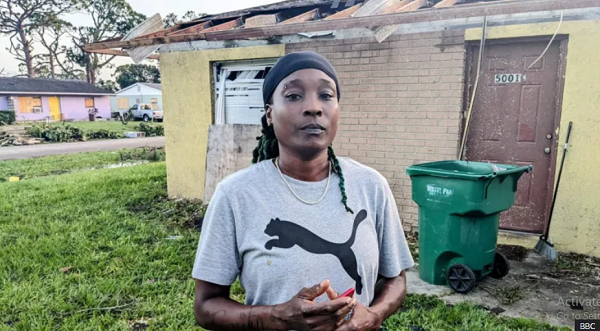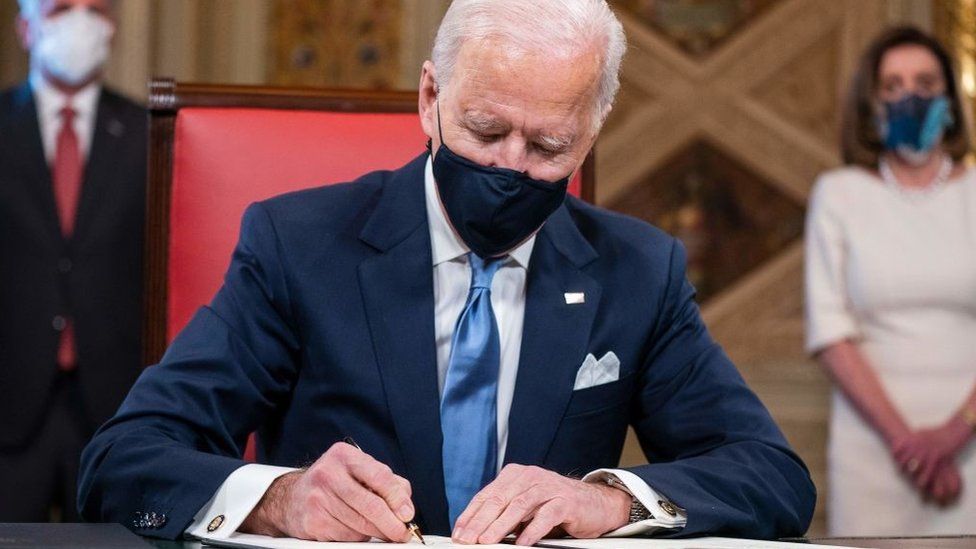‘The tornado was inside our house’ – Florida reels after Milton

Crystal Coleman sits outside the remnants of her home in St Lucie County, Florida, and wonders where she and her daughter will spend the night.
One of at least a dozen tornadoes spawned by Hurricane Milton tore through this low-income community on Florida’s east coast, killing at least five residents. At least 16 people are known to have died across the US state.
Crystal is happy to be alive but at a loss over what to do next.
“All of a sudden the door to my attic flew off, all the objects in my house started flying around,” Ms Coleman told BBC News on Thursday.
“It was devastating, we were very scared. It felt like the tornado was inside of our house.”
While Crystal’s neighbourhood was on Florida’s east coast, far from where Hurricane Milton first made landfall, tornadoes generated by the hurricane before its actual arrival caused devastation in this area.
The tornadoes spawned as Milton approached the state Wednesday evening – an occurrence that forecasters say sometimes follows tropical weather.
Parts of Crystal’s roof were torn off, and the windows blown out.
Further up the street on Thursday, workers at a non-profit organisation are handing out hundreds of hot meals. The power is out and there’s no running water. People are grateful for a hot meal, a smile, and a helping hand.
Devastation litters the main road. A tractor trailer on its side. The canopy ripped off a petrol station. Trees uprooted. Some residents say they’ve contacted the US Federal Emergency Management Agency (Fema) for help, but for now, they’re most worried about shelter and food for their families tonight.
Milton’s destructive path is still being assessed by workers across the state, who caution the death toll is likely to continue rising in the coming days.
The storm brought heavy rains of up to 18in (45cm) in some areas. Neighbourhoods and roads remain flooded; businesses, homes and stadiums were torn apart by the winds; and millions were left without power – but Florida Governor Ron DeSantis said the state did not experience “the worst-case scenario”.
Many evacuated, including some 80,000 people who stayed in shelters overnight, he said.
“My sense is that a lot of the people did leave who were in the evacuation zones,” DeSantis said.
Nevertheless, crews still deployed for hundreds of rescues across the state in large vehicles, boats and helicopters.
That includes more than 400 people alone who were rescued from a severely flooded apartment complex in Pinellas County and a US Coast Guard rescue of a ship captain who ended up in the water clinging to a floating cooler 30 miles (48km) from shore.
On Florida’s west coast, Maria Bowman, 60, hunkered down in her bright pink mobile home in North Fort Myers to ride out Milton’s fierce winds.
Her home, 600m from the Caloosahatchee River and at risk of storm surge, was in Evacuation Zone A – the category for the most at-risk areas.
She felt her home rattle as Milton came ashore. Her power cut out around 22:00.
“It sounded like an explosion,” she told BBC News. “Boom. No electricity.”
Ms Bowman, who says she’s dealt with numerous hurricanes, says she’s ready to leave the state.
“It’s too many hurricanes,” she said. “One day you survive it, the next time no. Who knows.”
Gov DeSantis warned that flooding remained possible in the coming days. He noted the death toll could continue to rise as the impact of the storm becomes more clear.
*Where is Hurricane Milton heading?
*Why Hurricane Milton caused tornadoes
*’My anxiety’s through the roof,’ says woman who did not evacuate
*Evacuees: ‘Waiting out Milton was gamble we weren’t willing to make’
*BBC Verify: No, Hurricane Milton was not ‘engineered’
Tampa Mayor Jane Castor has voiced relief that her city has not seen the type of storm surge that was feared.
But the region saw destruction.
In nearby St Petersburg, the Major League Baseball stadium that is home to the Tampa Bay Rays was severely damaged. Wind tore apart the stadium’s dome, which shines bright orange when the team wins a home game.
A crane also broke apart and collapsed in the middle of downtown St Petersburg, crashing into high rises as the storm blew through.
Castor and other officials have spent days urging people in Milton’s path to flee their homes or risk death.
Milton made landfall as a category three hurricane on Wednesday evening local time, bringing 124mph (200km/h) winds. Earlier in its life, it was categorised more than once as a category five hurricane – which denotes the most powerful type of storm.
The arrival of Milton comes two weeks after the south-eastern US was pummelled by Hurricane Helene, which killed more than 200 people and left many more missing. Clean-up operations are ongoing.
Milton, which later diminished into a post-tropical cyclone, travelled onwards over the Atlantic Ocean, north of the Bahamas.
*Does US lack relief money for Hurricane Milton?
*How Hurricane Milton compares to Hurricane Helene
*Is climate change making hurricanes and typhoons worse?
*Hurricanes: A look inside the deadly storms
Source: bbc.com





